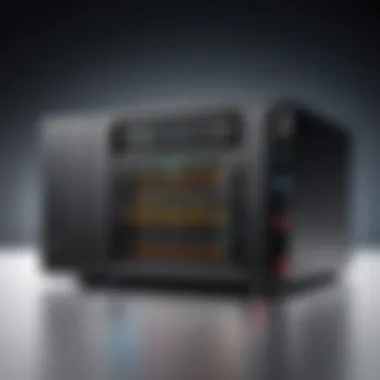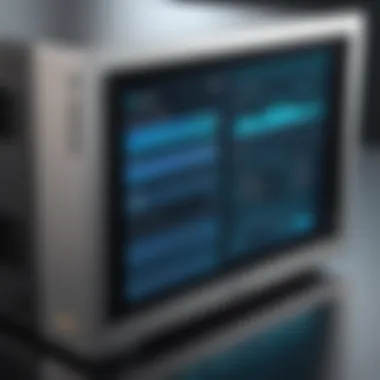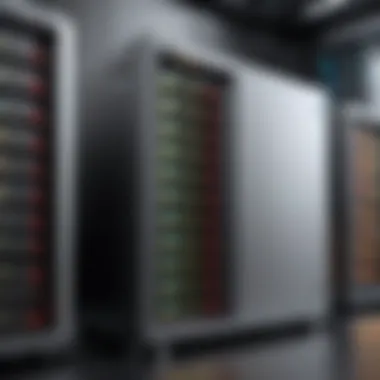Top NAS Solutions for Exceptional Value and Quality


Intro
In today's digital landscape, the demand for reliable data storage solutions is growing by leaps and bounds. Network Attached Storage (NAS) systems have emerged as a favorable option for both individuals and businesses looking to manage and safeguard their digital assets efficiently. But with a multitude of options available on the market, identifying the best value NAS products can feel like searching for a needle in a haystack.
This article aims to shed light on the key factors that play a vital role in selecting NAS systems that strike the right balance between price and performance. We’ll break down important aspects such as performance metrics, pricing structures, and the variety of features that can meet diverse user needs. By weaving together insights drawn from various angles, this guide is tailored for both tech enthusiasts and those just dipping their toes into the realm of storage solutions.
Get ready as we embark on this informative journey, ensuring every reader is equipped to make knowledgeable decisions regarding NAS technology.
Understanding NAS: An Overview
In recent years, Network Attached Storage (NAS) has become essential for both home users and businesses alike. It serves as a centralized storage solution, allowing multiple devices to access and share large amounts of data seamlessly. Understanding NAS is crucial because it lays the groundwork for making informed choices when you’re on the hunt for the best value NAS solutions.
What is NAS?
Network Attached Storage refers to a file-level storage device connected to a network, providing data access to a diverse range of clients, like computers, tablets, or smart devices. Instead of being tethered to one computer, NAS operates independently. Think of it as your own personal cloud, minus the monthly fees and security concerns associated with third-party services. Essentially, it allows users to store, retrieve, and share files with ease.
With the rise of digital media, businesses especially require efficient data management. In essence, NAS systems range from simple setups suitable for individuals to complex configurations tailored for enterprise needs.
How NAS Works
At its core, NAS functions by utilizing various protocols, primarily common Internet protocols such as SMB/CIFS and NFS, to facilitate data exchange. Here's how the gears typically turn:
- Connection: The NAS device connects to your local network, allowing it to communicate with connected devices.
- Access Protocols: When a device wants to access a file, it sends a request using the relevant protocols.
- Storage Access: The NAS retrieves the requested file from its hard drives and sends it back to the user’s device.
The performance of a NAS can depend on numerous factors, including the number of drives, their type, and the NAS' internal architecture. Usually, these systems are equipped with specialized operating systems optimized for file management.
"In a fast-paced digital landscape, having a reliable data storage solution like NAS isn't just a luxury; it's a necessity."
Benefits of Using NAS
Investing in a NAS offers numerous benefits, ranging from cost-efficiency to enhanced data security. Let's break down some of the standout advantages:
- Centralized Storage: All your data resides in one place, making backups and access much more manageable. This way, file versioning and disaster recovery become a more straightforward process.
- Scalability: As your data needs grow, NAS allows you to expand your storage easily. Many devices offer options to add more drives or even connect to different NAS units.
- Accessibility: Whether you’re at home, at the office, or on the go, you can access your files remotely, provided you've got an internet connection. This can be a game changer for professionals needing to collaborate across different locations.
- Cost-Effectiveness: Compared to traditional server setups, a NAS can often provide similar functionality at a fraction of the cost, especially when you consider maintenance and energy consumption.
By comprehensively understanding NAS, users can appreciate its potential, efficiently analyzing different models to pinpoint the best value solutions that align with their specific needs.
Assessing Value in NAS Solutions
Evaluating the worth of Network Attached Storage solutions is crucial in today’s tech landscape, where storage needs vary and budgets can be tight. It’s not just about splurging on high-end hardware; it’s about making choices that align with both immediate requirements and future demands. Understanding value means looking beyond the price tag. It involves examining what you actually need versus what’s just nice to have, especially in a world where the latest and greatest gadgets are constantly paraded in front of us.
When discussing NAS devices, assessing value encompasses several pivotal elements:
- Performance: How well does it actually perform the tasks you need it for? Speed and reliability are paramount.
- Cost: This includes both acquisition costs and ongoing expenses, such as energy consumption.
- Features: What unique functionalities does the device offer? Is cloud integration available?
- Future-Proofing: Can the device adapt as your needs change?
Understanding these aspects ensures that users make informed decisions that lead to sustainable storage setups.
Defining Value in Technology
In the tech realm, the term "value" can be somewhat evasive. It is often perceived as synonymous with "price," but reality paints a different picture. Value in technology is an intricate tapestry woven from various threads: functionality, reliability, and performance should all be considered when investing in a NAS.
The first step in defining value is assessing your specific requirements. If you’re a home user with modest storage needs, there’s no sense in picking a high-performance, enterprise-grade NAS. Choosing a device that’s tailored to your needs not only saves you money but also ensures that you’ll reap the maximum benefits without unnecessary features that sit idle. For businesses, the stakes might be higher, involving multiple users and the need for enhanced security. It’s all about striking the right balance between what you require and what you’re willing to invest.
Cost vs Performance Analysis
At its core, a successful NAS solution hinges on the balance between cost and performance. Here, one must ask: Are you getting what you pay for? For instance, a NAS that costs significantly more might boast exceptional read/write speeds, but if your usage doesn’t demand that level of performance, then you are better off opting for something more economical.


However, it's essential to remember that cheaper doesn't always mean better. Some low-cost devices might cut corners on build quality or lack critical features, leading to performance bottlenecks down the line. Therefore, conducting a thorough cost versus performance analysis allows potential buyers to weigh benefits against price points.
"In tech, the worst decision would be to save a few bucks today for a headache tomorrow.”
A systematic approach would involve:
- Researching benchmarks: Look at real-world performance tests conducted by other users.
- Considering user reviews: What have past customers experienced with their devices?
- Understanding warranty options: This can give insight into the manufacturer’s confidence in their product.
Long-Term Investment Considerations
The phrase "penny wise, pound foolish" rings true when dissecting long-term investment considerations in NAS solutions. While it might be tempting to take the cheapest route today, focusing solely on upfront costs ignores the broader picture and future implications. A device that seems affordable now may lead to increased operational costs tomorrow if it lacks expandability or requires replacements sooner than expected.
When evaluating long-term value, consider:
- Upgradability: Can you expand storage or improve performance in the future?
- Energy efficiency: More efficient models save on electricity and cooling costs over time.
- Manufacturer support and software updates: These are crucial for safeguarding data and enhancing performance in response to evolving cyber threats.
Investing in a quality NAS isn’t merely about its price today; it’s about envisioning how it will serve your needs in the long haul. By looking beyond initial expenditures and focusing on these long-term considerations, users can ultimately save both time and money, making their storage solution a truly valuable asset.
Key Features of Top Value NAS Devices
When looking for a NAS solution that packs a punch without breaking the bank, certain features take center stage. These key components act as the backbone of a solid NAS system, paving the way for great user experience and satisfaction. Knowing what to look for can make a world of difference, from the casual user wanting to store photos and videos, to a professional needing robust data management solutions.
Storage Capacity and Expandability
The first thing that often springs to mind is storage capacity. It's like the old saying goes, "you can't fit a square peg in a round hole;" if your NAS can't hold your data, it might as well be a fancy paperweight. Most users want a system that offers sufficient space to accommodate their current needs but also allows for future growth.
While a basic unit may come with a decent capacity, the ideal NAS should provide options for expansion. This means the ability to add more drives or even integrate with external storage solutions. Look for features such as:
- Hot-swappable trays that allow you to swap out drives without shutting down the system.
- Support for RAID configurations to strike a balance between performance and redundancy.
- Cloud access for off-site backup and increased storage flexibility.
Performance Specifications
Performance is another huge factor, as no one enjoys waiting for files to transfer at a snail's pace. High-speed connections are essential in today's fast-paced world. You wouldn’t want a dash of molasses in your data transfer, after all. Many devices come with features like:
- Multi-Gigabit Ethernet connections for speedy uploads and downloads.
- Powerful processors that can handle multiple tasks without buckling under pressure.
- RAM expansion capabilities to improve multitasking abilities.
Specifically, focus on hardware that supports 1 Gigabit per second connections or higher. Throughput may considerably change how you access and manipulate data.
User Interface and Accessibility
An intuitive user interface can make all the difference, especially for those who aren’t tech wizards. You could have the latest and greatest in NAS technology, but if the interface looks like it belongs in the last century, you might find yourself pulling your hair out. Key factors here include:
- Web-based management tools that are easy to navigate.
- Mobile accessibility so you can manage your storage on the go.
- App support that can extend functionality based on your needs.
A clean, responsive interface can save time and minimize frustration, enabling you to focus on what really matters—your data.
Data Protection and Recovery Features
In the unfortunate event something goes south, data protection features can spell the difference between a minor headache and a full-blown disaster. People often overlook how essential this is until it's too late. The best NAS solutions come with a variety of options like:
- Backup features that automate routine data saves.
- Snapshot capabilities to capture states of the system at specific times.
- Encryption options to safeguard sensitive information against unauthorized access.
Furthermore, being able to perform quick recoveries from hardware failure or accidental deletions should be a non-negotiable aspect of your NAS device.
Popular NAS Options in the Market


Understanding the various options available in the NAS market is crucial for anyone wanting to invest in a storage solution that meets their needs. This section will cover what’s out there, highlighting specific categories to cater to different user profiles, be it a casual home user, a small business, or those seeking high-performance setups. Navigating through these choices can feel like searching for a needle in a haystack, but by breaking them down, we provide clarity and direction.
NAS for Home Use
When it comes to home use, a NAS device serves not just as a storage unit, but almost as a multimedia hub. Families or individuals typically look for options that allow them to store large collections of photos, videos, and music, while also ensuring that access is seamless across various devices. Here are some important elements to consider:
- Storage Capacity: Look for models offering ample storage, around 4TB or more, with adequate room for future expansion.
- Ease of Setup: Most home users aren't deeply technical. Thus, units that come with user-friendly interfaces and guides are more appealing. Consider brands like Synology or QNAP which are often praised for their easy setup process.
- Multimedia Support: Features that allow streaming to different devices can enhance user experience. Look for support for formats like DLNA, which opens up possibilities for connecting to smart TVs or gaming consoles.
A popular choice for home users is the Synology DiskStation DS220+, known for its balance of price and performance, offering users the comfort of simplicity without compromising capabilities.
NAS for Small Businesses
Small businesses often find themselves in a different ballpark when it comes to NAS. The focus is often on reliability and data security, which are critical as businesses rely heavily on their data. Here are aspects to keep in mind:
- Performance: Speed matters. A NAS that can handle multiple users simultaneously without lag is essential. Models with faster processors and multiple gigabit Ethernet ports could save you lots of frustration.
- Data Protection: Options with RAID configurations for data redundancy are important. This way, if a hard drive fails, the data isn’t lost.
- Collaboration Features: Many small teams require the ability to share files easily. Choose a NAS with tools that support multi-user access and file versioning.
For small businesses, the TerraMaster F2-221 is worth mentioning due to its reliability and a price point that won’t break the bank while delivering good performance.
High-Performance NAS Solutions
High-performance NAS solutions are often necessary for organizations dealing with large files or looking to enhance their digital operations significantly. Think video production companies or software development teams. Here are vital considerations:
- Advanced Features: Features like SSD caching and 10GbE connectivity make all the difference when dealing with massive data loads.
- Scalability: Investing in a solution that can grow with the organization is wise. Look for models that allow additional drive bays for easier expansion.
- Enterprise Integration: If there’s a need for integration with existing systems, like virtualization environments or databases, choose a NAS that caters to such requirements.
An example is the QNAP TS-283XU-RP, noted for its powerful performance and flexibility, catering to high-demand environments deftly.
In summary, when selecting a NAS solution, be mindful of the unique requirements of your context—whether at home, in a small business, or in a high-performance setting. Each category comes with its preferences and specifications that can profoundly affect efficiency and satisfaction.
Comparative Analysis of Leading NAS Brands
When diving into the myriad of options available in the NAS market, comparative analysis becomes a vital tool. This section sheds light on the strengths, weaknesses, and unique offerings of the leading brands in this space. Understanding these differences helps individuals and organizations make sound choices.
It's not just about picking a device off the shelf; the tale runs deeper. Consumers need to decipher which brand resonates with their technical needs and budget constraints. A thorough comparative analysis cultivates an awareness of industry standards and brand reliability, which can safeguard against future headaches.
Brand A Overview
Brand A is a name that often crops up in conversations about dependable NAS solutions. Their devices are known for a combination of user-friendliness and robust performance. One of the pivotal features of Brand A NAS units is their intuitive interface. Users – from tech novices to seasoned professionals – find that they can navigate the system with ease.
When it comes to specifications, Brand A's products typically emphasize scalability. They usually offer a generous storage capacity that caters to both individual users and larger teams, making them a versatile choice. Added to this is their active community support; many users turn to forums such as reddit.com to seek advice or troubleshoot issues, creating a strong support network.
Brand B Overview
Brand B ensures that users experience the best of both worlds: performance and affordability. The standout feature of Brand B is its impressive data security options. Many users cite their comprehensive backup solutions as a game-changer, especially for businesses that handle sensitive information.
Additionally, Brand B models typically come equipped with an advanced protocol support that enables seamless integration with various operating systems. This adaptability is crucial for people with diverse setups. Many professionals in IT-related fields commend Brand B for being a reliable partner, often emphasizing its consistent updates and security patches, which ensure ongoing protection against risks.
Brand Overview
Brand C is marked by high performance and is often regarded as the go-to for intense workloads. Whether it's multimedia consumption or heavy data processing, Brand C rises to the occasion. Their high-speed connectivity options typically attract those with demanding requirements, such as software developers and businesses managing large databases.
Furthermore, Brand C offers a range of customizable solutions. This is significant for discerning users who prefer to tailor their NAS units to fit specific operational needs. However, potential buyers should be mindful of the pricing structure; while the features are top-notch, they tend to come at a premium. Evaluating whether Brand C's solutions align with budget expectations is a crucial step before making a purchase.
"Choosing the right NAS brand is akin to finding the perfect partner; it should align with your needs and grow with you over time."
The comparisons highlighted here lay a foundation for understanding what each brand brings to the table. By analyzing Brand A, B, and C, individuals can clarify their own requirements and ultimately arrive at a better informed decision.


User Considerations When Choosing NAS
Choosing the right Network Attached Storage (NAS) system is no small feat. Much like selecting the perfect shoes that suit your needs and style, picking a NAS requires careful thought about a few key factors. Understanding user considerations fundamentally shapes the decision-making process. It's not just about what the latest model has to offer or the flashiest brand name; it’s about matching the capabilities of the NAS to your specific requirements.
Assessing Storage Needs
First and foremost, one must assess their storage needs. This entails taking a long, hard look at what kind of data you will be storing. Is it merely a home setup for photos and videos, or are you looking for something capable of handling large databases and multiple user access? The amount of data you expect to store is paramount. A NAS with insufficient capacity can lead to headaches down the line.
Say for instance, you're an avid gamer with a vast collection of games, then a system that offers at least 10TB of storage might feel just right. On the flip side, if you're looking to back up some family photos, perhaps a smaller capacity would suffice. Here’s a useful list to consider:
- Type of Data: Are you saving documents, media files, or backups?
- Current and Future Needs: How much data do you have now, and how much do you expect to grow into?
- Redundancy Requirements: Will you need RAID configurations for added protection?
Evaluating Technical Experience
Consider your technical experience as well. It’s one thing to know what a NAS does; it’s another to navigate its setup and functionality. If you’re well-versed in tech, a more complex NAS might not scare you off—after all, tearing into configurations could be a part of the thrill. But for someone who might feel like they're all thumbs, opting for a simpler interface is absolutely advisable.
Here’s a breakdown of what to ponder:
- Tech Savvy vs. Basic User: Consider who will be using the system predominantly.
- Setup Complexity: Are you comfortable with network configurations, or do you want something plug-and-play?
- Support Resources: Does it provide enough documentation and community support to help you along the way?
Understanding Network Infrastructure
Lastly, grasping your network infrastructure is key. You might have the fanciest NAS on the market, but if your home or office Wi-Fi leaves something to be desired, it won’t be as effective as it should be. Your NAS will need to be able to communicate with other devices seamlessly for you to unlock its full potential.
Questions to think about include:
- Network Speed: Is your internet or local network fast enough to take advantage of the NAS features?
- Router Compatibility: Will your existing router support the NAS speed and features?
- Expansion Potential: If you plan to upgrade your network later, consider those capabilities now.
"The best NAS solution is the one that fits like a glove—tailored to your needs rather than a one-size-fits-all approach."
By understanding these user considerations when choosing a NAS, individuals and businesses alike can cut through the noise and make informed decisions that will not only protect their data but ultimately foster operational efficiency in the long run.
The Future of NAS Technology
As we navigate the ever-evolving landscape of data management, understanding the future of NAS technology is no longer just an academic exercise; it's a pressing necessity. The demands for efficient, secure, and scalable storage solutions continue to surge. Small to mid-sized enterprises, along with individual users, are increasingly depending on these systems to handle intricate workloads and safeguard critical data. In this swiftly digitalizing world, identifying the trends and potential advancements in NAS technology is paramount in making viable choices.
Emerging Trends in NAS Design
The design of NAS units is undergoing transformation, integrating aesthetics with functionality. Manufacturers are now paying great attention to compactness and design appeal, not merely performance. Expect to see:
- Rack-Mounted Systems: Increasingly popular in commercial setups, these systems allow effective use of space, accommodating numerous devices efficiently.
- Modular Designs: Offering flexibility, modular systems enable users to add or remove components based on their changing needs, reducing waste and optimizing resource use.
- Accessibility Features: Advances in user interfaces mean that NAS management is becoming more intuitive, allowing even less tech-savvy individuals to navigate and maintain their systems easily.
These trends reflect a needed shift toward user-friendly solutions that merge style with state-of-the-art technology.
Integration with Cloud Services
The lines between local NAS systems and cloud storage are becomingblurred. The trend is moving towards hybrid solutions, where NAS devices work seamlessly with cloud services. This integration offers several advantages:
- Data Redundancy: By using cloud backups in tandem with local storage, users enhance their data protection strategies.
- Scale on Demand: Businesses can scale their storage needs with a click when they use cloud services alongside NAS. It provides room to grow without the headache of continuous hardware upgrades.
- Remote Accessibility: Cloud integration enables users to access their data from anywhere, creating a more flexible workspace.
As cloud services continue to gain traction, this trend highlights an essential evolution in how organizations approach data storage.
Sustainability in NAS Solutions
In the age of climate consciousness, sustainability has become a hot topic in technology, including NAS solutions. Manufacturers are recognizing the need to make their products more eco-friendly. This includes:
- Energy Efficiency: Devices are now being designed with energy-saving technologies, enabling lower carbon footprints.
- Recyclable Materials: Going green goes beyond just functionality; it encompasses the materials used. Many companies are leaning toward using recyclable parts in their NAS devices.
- Circular Economy Principles: Rather than a "throwaway culture," there is a growing emphasis on designing systems that can be easily upgraded or repaired, minimizing waste.
Adopting sustainable practices isn't just about corporate responsibility; it's increasingly becoming a key part of marketability and consumer choice.
By embracing the evolution in NAS technology, users can tap into a future that not only meets their storage needs but also aligns with their values and expectations of quality.







